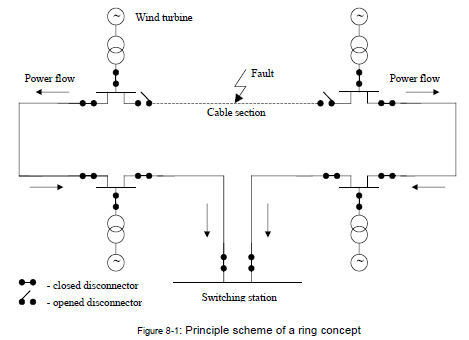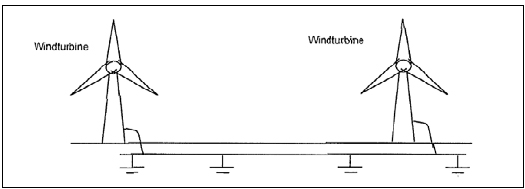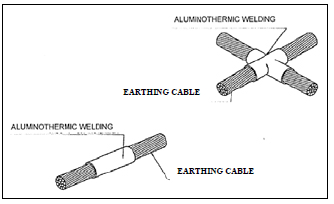Click here to register!
Internal Wind Park Cabling
Cabling Concept
There are two common base alternatives for an internal cabling concept: radial feeders and ring feeders.The ring feeder concept is the most reliable concept, based on the n-1 criteria. N-1 criteria ensure that the disconnection of any equipment of the network is allowed without serious consequences for the total network. This is valid for the grid devices like cables, transformers, substations, busbars, etc. In the case of a cable section fault, the corresponding cable section will be disconnected automatically, and all wind turbines will still keep in power production, supplying in both directions through the operative cable sections, as shown schematically in the following figure.
However, the ring concept is more expensive than the radial concept because the double cable length (preferably even in a separate trenches), the additional two disconnectors for each cable section, as well as an additional switching station feeder for each ring in order to ensure the ring concept.
The radial feeder concept is more economical than ring feeder. There is only one way cable necessary for each area. In case of a wind turbine or transformer fault, the corresponding device will be disconnected and the remaining wind turbines stay connected to a feeder and still produce power. The main disadvantage of this concept is the low reliability in case of a cable section fault (short circuit). The whole feeder will be disconnected for a time period for the repairing works. The principle scheme of the radial concept is shown in the following figure:
It is advantageous to implement the internal cabling with several radial feeders in order to increase the generation availability (in case of above described cable section fault only one feeder will be disconnected and remaining one will still supply the power to grid).
Cable Type
The internal cable connection of the wind turbines is realised by 33 kV underground XLPE aluminium cables. The 33 kV is one of the standard medium voltage level used in Ethiopia. Underground cables are necessary in wind parks because the trucks and cranes need free space for operation. Since the voltage level of the wind turbine generator is 400 V (Enercon E-48), at the base of
each wind turbine, a transformer steps-up the voltage to the 33 kV for internal park transmission.
The selection of the optimal cable type depends on both the arrangement and grouping of wind turbines (number and power of turbines) and also the choice of feeder concept. All wind turbines are divided into four groups: first 2 groups consisting of 16 wind turbines with capacity of 12.8 MW each, a third group of 15 wind turbines and 12 MW and the remaining group consisting of 14 wind turbines, with power capacity of 11.2 MW each. This group allocation is more reliable, from the technical point of view, such as reduction in electrical losses, reliability and availability in fault cases etc.
The selection of the optimal cable type is standard cable cross sections used according to Wind turbine specification with respect to its thermal and mechanical stress. Considering load factor, operating temperature, climatic and operational factors, the suitable cable cross section is chosen on basis of the standard local cable characteristics.
The values are calculated for one to two cable circuit in the trench, U = 1.05 Urated, cos phi = 0.95 and rated current density from 0.13 to 1.8 A/mm2 for aluminium conductors. The cable cross section of 300 mm2 for the aluminium conductors is sufficient for transmission of required feeder load.
Due to the selected radial feeder for internal cabling concept, only the cable sections of each feeder connected to the switching station shall be designed to transfer 12.8 MW.
Due to the selected radial feeder for internal cabling concept, the cable sections shall be designed to transfer an installed power from 11.2 MW to 12.8 MW. In order to optimise the cable costs, at least two cross sections of cable design, with safety margin, of 120 mm², 300 mm² aluminium conductor cables will be used. The cost estimation is based on the internal uniform cable design with safety margin: 120 mm² and for the feeder connection 300 mm² aluminium conductor cable.
Feasibility Study for Wind Park Development in Ethiopia and Capacity Building
Earthing Network
Due to the design for the wind park Mesobo, and availability of information about the Mekelle Substation, the earthing cable to be used in the wind farm shall be at least 95 mm² Copper cable.
The earthing network is composed by the wind turbines earthing system, and the wind farm earthing connection. In order to have a system at the same electrical potential, each wind turbine is connected to, at least, one other wind turbine.
The earthing network of the wind farm is composed of copper cables of 95 mm² to be installed directly on the trench.
Earthing rods shall be solid, copper-clad steel rods with a minimum diameter of 16 mm with provision for coupling together with a suitable clamp for connection of the ground wire. The copper coating shall have a minimum thickness of 0.3 mm. The earthing rod arrangement shall have the principle layout.
The ground wire shall be directly connected to the pole with bolted connectors, of an approved material, suitable for use with the ground wire such that galvanic action, i.e. chemical reaction between copper and galvanised steel, is minimised.
Connections to the substations earthing grid shall be made by compressed clamps or bolted connectors of approved design. The earthing of the wind park shall be connected to the existing ground network in the substation.
The terminal tower should always be connected to the substation earthmat. The reason for bonding the terminal tower to the substation earthmat is to obtain a very low impedance at the terminal tower in order to prevent a back-flash at the terminal tower in the event of lightning striking the terminal tower.
If the terminal tower cannot be bonded to the substation earthmat, the tower footing resistance of the thermal tower on its own should then be reduced to less than 10 ohm in order to still prevent back-flash at the terminal tower, in the event of lightning striking the terminal
tower.
Determination of Wind Turbine Groups
The proposed wind turbines will be arranged in four groups, where first two groups are divided into equally installed power capacity of 12.8 MW, another group with 15 turbines of 12 MW and the remaining group consisting of 14 units of 9.6 MW as shown in table 1. The division into the groups with 14-16 units is advantageous from the technical point of view, such as reduction of electrical losses, reliability and availability in fault cases etc.
Switching Station
Within the proposed internal cabling concept, there are four incoming radial feeders to the switching station busbars and one outcoming overhead transmission line connection to the transformer 15 kV /132 kV / 230 kV, busbar of the 132 kV Voltage level into the Ethiopian
power grid.
It is advantageous to locate the 33 kV switching Station in the central area of the Wind Park (61 units). The length of cable and overhead transmission line can be reduced with the proposed implementation and problems regarding electrical parameters such as voltage drop, higher power losses, cable costs etc. can be avoided.
For the transmission of max. 48.8 MW, a 60 MVA 132 kV / 33 kV power transformer is needed. There are four 33 kV cable feeders incoming to the substation busbar. One of 33 kV and one of 132 kV busbars are additionally required.
In order to optimise the reliability and maintenance costs, at least, a SF6 gas insulated switching station is recommended for implementation, due to the atmospheric conditions at the 2,400 m altitude of the Mesobo wind park. The switching station is located centrally between the proposed wind turbine groups, dividing the wind park line into four radial feeders with 2x16 and 1x15 and 1x14 wind turbines accordingly. The distance between switching station and wind turbine should be minimum 150 m.
























